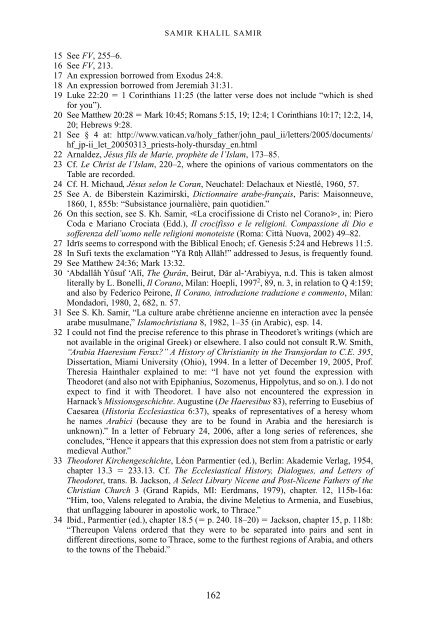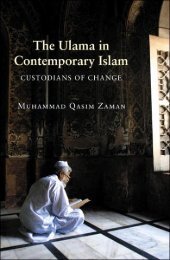The Qur'an in its historical context (pdf - Islam and Christian-Muslim ...
The Qur'an in its historical context (pdf - Islam and Christian-Muslim ...
The Qur'an in its historical context (pdf - Islam and Christian-Muslim ...
Create successful ePaper yourself
Turn your PDF publications into a flip-book with our unique Google optimized e-Paper software.
SAMIR KHALIL SAMIR<br />
15 See FV, 255–6.<br />
16 See FV, 213.<br />
17 An expression borrowed from Exodus 24:8.<br />
18 An expression borrowed from Jeremiah 31:31.<br />
19 Luke 22:20 � 1 Cor<strong>in</strong>thians 11:25 (the latter verse does not <strong>in</strong>clude “which is shed<br />
for you”).<br />
20 See Matthew 20:28 � Mark 10:45; Romans 5:15, 19; 12:4; 1 Cor<strong>in</strong>thians 10:17; 12:2, 14,<br />
20; Hebrews 9:28.<br />
21 See § 4 at: http://www.vatican.va/holy_father/john_paul_ii/letters/2005/documents/<br />
hf_jp-ii_let_20050313_priests-holy-thursday_en.html<br />
22 Arnaldez, Jésus fils de Marie, prophète de l’<strong>Islam</strong>, 173–85.<br />
23 Cf. Le Christ de l’<strong>Islam</strong>, 220–2, where the op<strong>in</strong>ions of various commentators on the<br />
Table are recorded.<br />
24 Cf. H. Michaud, Jésus selon le Coran, Neuchatel: Delachaux et Niestlé, 1960, 57.<br />
25 See A. de Biberste<strong>in</strong> Kazimirski, Dictionnaire arabe-français, Paris: Maisonneuve,<br />
1860, 1, 855b: “Subsistance journalière, pa<strong>in</strong> quotidien.”<br />
26 On this section, see S. Kh. Samir, �La crocifissione di Cristo nel Corano�, <strong>in</strong>: Piero<br />
Coda e Mariano Crociata (Edd.), Il crocifisso e le religioni. Compassione di Dio e<br />
sofferenza dell’uomo nelle religioni monoteiste (Roma: Città Nuova, 2002) 49–82.<br />
27 Idris seems to correspond with the Biblical Enoch; cf. Genesis 5:24 <strong>and</strong> Hebrews 11:5.<br />
28 In Sufi texts the exclamation “Ya Ruh Allah!” addressed to Jesus, is frequently found.<br />
29 See Matthew 24:36; Mark 13:32.<br />
30 ‘Abdallâh Yûsuf ‘Alî, <strong>The</strong> Qurân, Beirut, Dar al-‘Arabiyya, n.d. This is taken almost<br />
literally by L. Bonelli, Il Corano, Milan: Hoepli, 1997 2 , 89, n. 3, <strong>in</strong> relation to Q 4:159;<br />
<strong>and</strong> also by Federico Peirone, Il Corano, <strong>in</strong>troduzione traduzione e commento, Milan:<br />
Mondadori, 1980, 2, 682, n. 57.<br />
31 See S. Kh. Samir, “La culture arabe chrétienne ancienne en <strong>in</strong>teraction avec la pensée<br />
arabe musulmane,” <strong>Islam</strong>ochristiana 8, 1982, 1–35 (<strong>in</strong> Arabic), esp. 14.<br />
32 I could not f<strong>in</strong>d the precise reference to this phrase <strong>in</strong> <strong>The</strong>odoret’s writ<strong>in</strong>gs (which are<br />
not available <strong>in</strong> the orig<strong>in</strong>al Greek) or elsewhere. I also could not consult R.W. Smith,<br />
“Arabia Haeresium Ferax?” A History of <strong>Christian</strong>ity <strong>in</strong> the Transjordan to C.E. 395,<br />
Dissertation, Miami University (Ohio), 1994. In a letter of December 19, 2005, Prof.<br />
<strong>The</strong>resia Ha<strong>in</strong>thaler expla<strong>in</strong>ed to me: “I have not yet found the expression with<br />
<strong>The</strong>odoret (<strong>and</strong> also not with Epiphanius, Sozomenus, Hippolytus, <strong>and</strong> so on.). I do not<br />
expect to f<strong>in</strong>d it with <strong>The</strong>odoret. I have also not encountered the expression <strong>in</strong><br />
Harnack’s Missionsgeschichte. August<strong>in</strong>e (De Haeresibus 83), referr<strong>in</strong>g to Eusebius of<br />
Caesarea (Historia Ecclesiastica 6:37), speaks of representatives of a heresy whom<br />
he names Arabici (because they are to be found <strong>in</strong> Arabia <strong>and</strong> the heresiarch is<br />
unknown).” In a letter of February 24, 2006, after a long series of references, she<br />
concludes, “Hence it appears that this expression does not stem from a patristic or early<br />
medieval Author.”<br />
33 <strong>The</strong>odoret Kirchengeschichte, Léon Parmentier (ed.), Berl<strong>in</strong>: Akademie Verlag, 1954,<br />
chapter 13.3 � 233.13. Cf. <strong>The</strong> Ecclesiastical History, Dialogues, <strong>and</strong> Letters of<br />
<strong>The</strong>odoret, trans. B. Jackson, A Select Library Nicene <strong>and</strong> Post-Nicene Fathers of the<br />
<strong>Christian</strong> Church 3 (Gr<strong>and</strong> Rapids, MI: Eerdmans, 1979), chapter. 12, 115b-16a:<br />
“Him, too, Valens relegated to Arabia, the div<strong>in</strong>e Meletius to Armenia, <strong>and</strong> Eusebius,<br />
that unflagg<strong>in</strong>g labourer <strong>in</strong> apostolic work, to Thrace.”<br />
34 Ibid., Parmentier (ed.), chapter 18.5 (� p. 240. 18–20) � Jackson, chapter 15, p. 118b:<br />
“<strong>The</strong>reupon Valens ordered that they were to be separated <strong>in</strong>to pairs <strong>and</strong> sent <strong>in</strong><br />
different directions, some to Thrace, some to the furthest regions of Arabia, <strong>and</strong> others<br />
to the towns of the <strong>The</strong>baid.”<br />
162



